Dedicated to the Art
and Artists
of Relief Printmaking
15685 SW 116th Ave
PMB 202
King City, OR
97224-2695 USA
Phone: 503-641-3555
FAX: 503-641-3591
Orders: 800-832-4264
imcclains.com
You can instantly unsubscribe from these newsletters at the bottom of this page.
Go to McClain's On-line Catalog
Request a catalog |
June 2007
INTERVIEW________________________________________ |
|
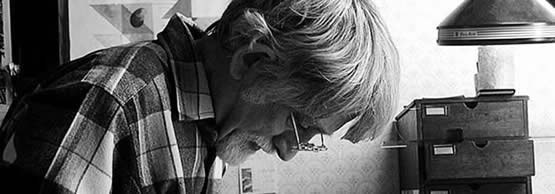 Richard Steiner Richard Steiner
We recently interviewed Richard Steiner, a moku hanga (Japanese-style) printmaker living in Kyoto, Japan. Steiner will be teaching both a beginner and an advanced moku hanga workshop this August at Marylhurst University in Portland, Oregon. For more information about the workshops or to sign up, click here. The workshop is co-sponsered by McClain's and PAN (Print Arts Northwest).
Steiner was born in Saginaw, Michigan, in 1939. He started his artistic career as a fashion photographer in New York City. In 1970 he moved to Japan to teach English. It was there that he discovered the art and craft of moku hanga and in 1997 he co-founded KIWA, Kyoto International Woodprint Association. Japan is now his home.
McClain’s:
How did woodblock printmaking make its way into your life? What about it captivated you?
Richard Steiner:
As an English teacher, I had lots of free time and, in those days, lots of money (the exchange rate in 1970 was ¥360 to $1.00. That made me very wealthy the moment I stepped off the plane.) So, to while away my time, I began to study flower arrangement, brush calligraphy, and woodblock printmaking. All of them interested me muchly, but chopping wood quickly got to my heart. Why? I like working with my hands; I like wood; I like art: it is my whole life. And I love the idea of making many copies of the same work, which is the whole point of a printmaking medium. If one does a really fine piece of artwork, why can’t hundreds of appreciators have it on their walls? The whole point of printmaking is making copies, which puts me at odds with the majority of other printmakers, not to mention the galleries and collectors. There is no tradition in Japan of doing numbered editions. This also appealed to me a great deal.
Click here to see Richard's images and to read the interview.
|
| |
|
PRODUCTS________________________________________ |
|
Hanga Sagyodai: bench hook
Our Bench Hooks just got better!
We have designed a new horizontal bench hook to support your wood in all directions.
Most carvers have several bench hooks to support blocks of different sizes and shapes. Our bench hooks are made from 3/8" thick shina plywood. The end boards are both glued and nailed for durability. The top board is open in the center so the block can be placed at any angle for easy carving.
The purpose of a bench hook is to hold your block in place so you can keep both hands on your tool when carving. They also protect tabletops from slips of the tool and are indispensable when using a mallet to drive a carving tool through the wood. With our new design it is easy to slide a horizontal block to any position you like.
If you need a custom-sized bench hook we are happy to oblige. Just fill out the online form, or call us with the dimensions. |
|
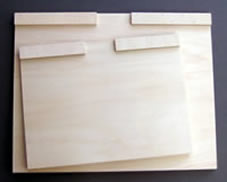
Horizontal Bench Hooks
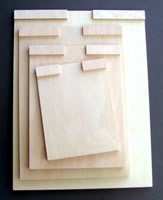
Vertical Bench Hooks |
|
| TIPS______________________________________________ |
Transferring Images
There are countless ways to get your image onto a wood block. You can sketch directly onto the block with anything from a soft pencil, gouache, Sumi ink, to felt tip pens. Beware of hard pencils as they can leave dents on your wood block that can show up in your print.
Here's one transfer technique, very similar to the way Ukiyo-e carvers traditionally transferred a drawing, that works very well and preserves all the detail of the original.
|
Transferring Images with Usu Mino:
Usu Mino is a very thin, lightweight mending tissue that can be used for tracing as well as transferring printed images.
Step 1:
Cut Usu Mino to the size of your wood block. Now make your drawing directly onto the paper and proceed to step two, or lay the Usu Mino on top of your existing original drawing and secure it in place with low-tack tape. Trace the image onto the Usu Mino.
Remember to include the Kento marks as you trace your image |
 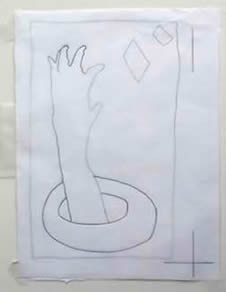
|
|
Step 2:
With a brush or a foam paint roller, apply a thin, even, undiluted coat of Nori to your woodblock.
FLIP THE USU MINO OVER so your image is reversed.
The paper is thin enough to see your marks through the backside. If you forget this step your image will print backwards! Lay the Usu Mino on top of the block and anchor the paper on one edge.
|
 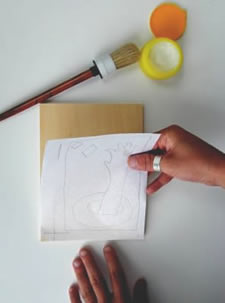
|
Step 3:
Smooth out the paper with a dry stiff brush like a stippling brush. Be sure to make firm contact and get all air bubbles out.
When the Nori has dried (overnight drying is ideal), your block is ready to carve - right through the paper!
|
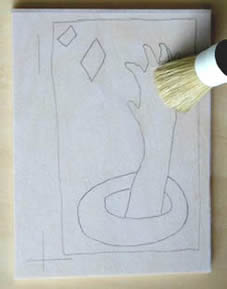 |
|
Step 4:
After carving your block, remove the remaining paper. This is easily done by laying a wet rag on the surface or brushing water over the area. Since nori is reversible, it reactivates with water and the paper easily lifts off.
Once the block is clear of paper, nori and water, print it as you usually would. If you are doing a multi-color print, carve your key block first.The key block is the section that contains all the central compositional elements, like the outline. Print the key block onto another piece of Usu Mino, determine what your next block will be (like the lightest color) and return to step 2!
|
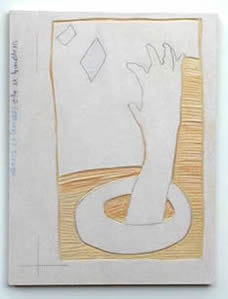
|
|
| NEWS____________________________________________ |
Good-bye B!
Brandon, McClain's newsletter editor, is moving on. In addition to writing the newsletter, Brandon wore many hats in the office. He's a funny, and creative guy who always has a movie to recommend and a song to sing. We wish him luck and prosperity with his nursing studies!
To view Brandon's work visit his web site:
http://factoryb.com
|
 |

|
|
|
|

 Richard Steiner
Richard Steiner





